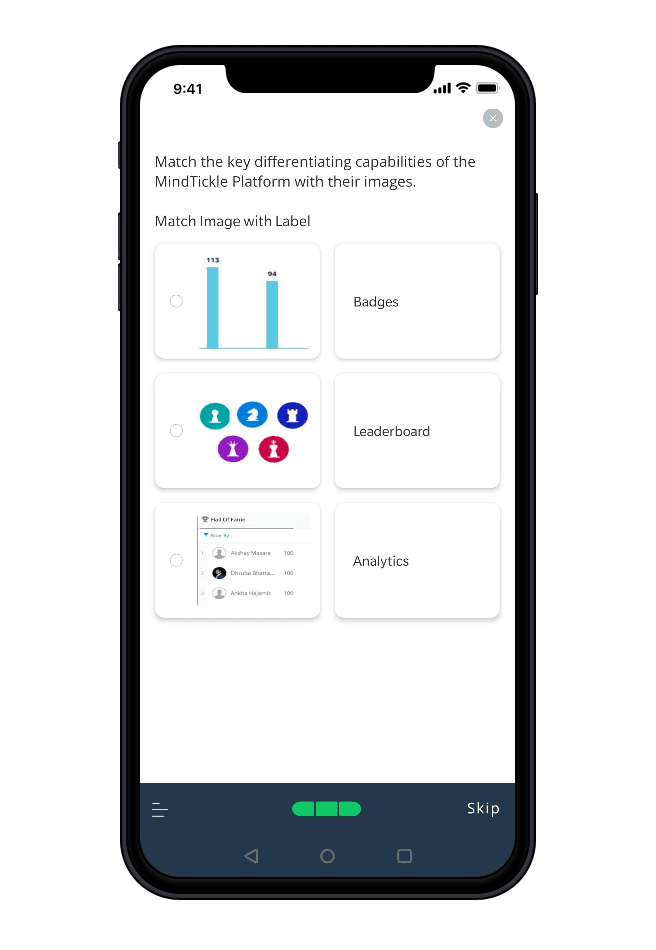I’m often asked by sales leaders about how to ensure that sales onboarding delivers long-lasting results. After all, you spend so much time and energy hiring and onboarding new sales reps, but like a shiny new car, your investment depreciates the minute they step outside. Trying to reinforce sales training is a challenge many enablement leaders face.
It is natural for the reps to forget the training content and even if they retained everything the readiness of your reps will decline on a relative scale because it is a moving target. Competitors change strategy, industry dynamics change, you introduce new product features or you have published new referenceable case studies.
It’s not only important to help your newbies maintain their level of knowledge by reinforcing their training, but also to sustain their overall sales readiness so they can continue to level up. Therefore, reinforcement is a critical part of an effective onboarding program.
But how should one go about creating a reinforcement plan for new reps that delivers the goods? Some of your gaps for new reps may be knowledge related, while others may be behavioral. So it’s important to use different methods of reinforcement to target specific issues. To get your reps on their way to achieving their sales quota, here are 5 best practices:
Implement periodic refreshers to reinforce sales training
Broadly, speaking there are two types of sales training formats – baseline training modules (think of them as long-form modules that provide a well-structured and comprehensive knowledge about a subject matter, and bite-sized updates to refresh the knowledge imparted in the training modules. These updates when delivered in the right context can not only serve to refresh the knowledge of your sales reps, but they can also help the sales reps connect the dots on how those pieces of information can help them win more deals. Here are a few examples:
- Send out a cheat sheet on how to handle specific customer objections or one that outlines the steps to complete one part of the sales process
- Send out bite-sized updates on specific product features and how they contribute to the value proposition
- Set reminders in SalesForce at points in the process that are critical to CRM compliance
- Send a short reminder on their mobile phone that outlines how an A Player prepares for a meeting
Some of your priorities may be knowledge related, while others may be behavioral. So it’s important to use different methods of reinforcement to target specific issues.
Spot check sales readiness
Quick pop-quizzes are a great way to periodically test and reinforce what your sales reps have retained. When combined with explanations for the quiz answers, these quizzes can serve to enhance the knowledge of the reps. This can be particularly useful for small nuggets of information that are easily forgotten.
Mindtickle has over eight different types of quizzes that can make this quite simple to implement, and provide you with data on how your reps performed on each question as well. For example, use a multiple choice question to test their knowledge of the value proposition or label matching to update them on the benefits of a new product feature.

Reinforce sales training with coaching and simulation exercises
While a structured coaching plan should already be part of your sales onboarding, you can reinforce specific skills and troubleshoot issues using mini-simulations. For example, if there is a specific objection that many reps struggle to deal with, you can have them record their response and then go over this with them in your next feedback session. And if done on a regular basis, such exercises help ensure that all sales reps have consistent messaging.
Mindtickle offers an automated workflow for managing these simulation exercises called Sales Missions. Sales managers can create online exercises for their team members which require them to submit an audio-video recording of how they would respond to a sales situation. These could range from cold pitches, elevator pitches, leaving voicemails to handling specific customer queries or objections. These bite-sized missions should take no more than 5 minutes for the rep to do but can help provide very actionable feedback.
Mentoring
You already know your high-performing quota carriers are the best inspiration you can give to a new hire, but they can also help them reinforce the best practices they’ve heard about during their onboarding. By establishing a formal mentoring program or even an informal buddy system, your new hires can hear success stories and winning strategies directly from your rockstars. When positioned as a buddy or mentor relationship, the new hires are likely to be more open to asking questions that they perhaps might consider too “dumb” to ask their manager.
Certain sales leaders do not want to spare a minute of their top sellers for such mentoring activities. I believe that is a short-sighted approach and can be detrimental to the career progression of your “A player” sales reps. Such mentoring programs have dual benefits in the long term. Not only are they beneficial for the newbies, they also offer an opportunity to your “A” reps to get a first-hand experience of essential managerial skills such as coaching, as the first step towards graduation to senior roles.
Make it mobile
By ensuring that reinforcement content and activities are made available to the reps on their mobile devices, those interactions will be integrated into your reps daily routine and quickly become just another part of their everyday sales activities. Moreover, for reinforcement to be effective, the tips and refreshers are much more meaningful when presented in the context of customer situations. For example – the value of a case study or a win story would be most appreciated by a sales rep when presented in the middle of a similar deal that he/she may be assisting with.
Bonus tip: Amplify the impact of reinforcement by leveraging the power of analytics
According to the Aberdeen Group, 20% more sales reps achieve quota when their team implements post-training reinforcement. But before you jump straight in, you must prioritize the key capabilities that you want your reps to focus on, and then determine how best to reinforce those. For example, ensuring that they fully understand your customer personas may be a challenge for some, or many may find CRM compliance to be a pain point. This is where analytics and data can play a big role again.
At Mindtickle, we export the learning performance (scores in quizzes, engagement metrics, and results from pitch testing) in order to create groups of new hires based on their development needs. This data has also been very useful for us to create a standardized refresher track that applies to all new hires.
For example – we observed that most new hires find it hard to retain the advanced functionality of the Mindtickle analytics. Additionally, our data also tells us that the A player reps on our team have consistently shown a very high degree of awareness regarding competition. So we added competition battle-cards to the reinforcement track and additional reinforcement on advanced analytic functionality.







